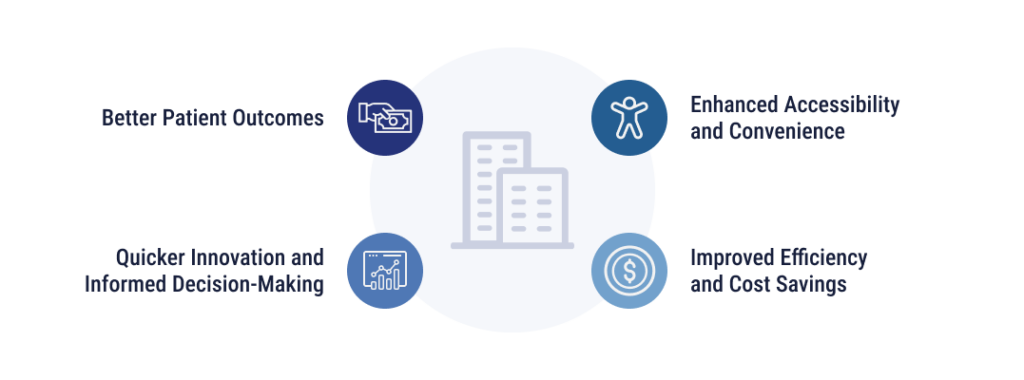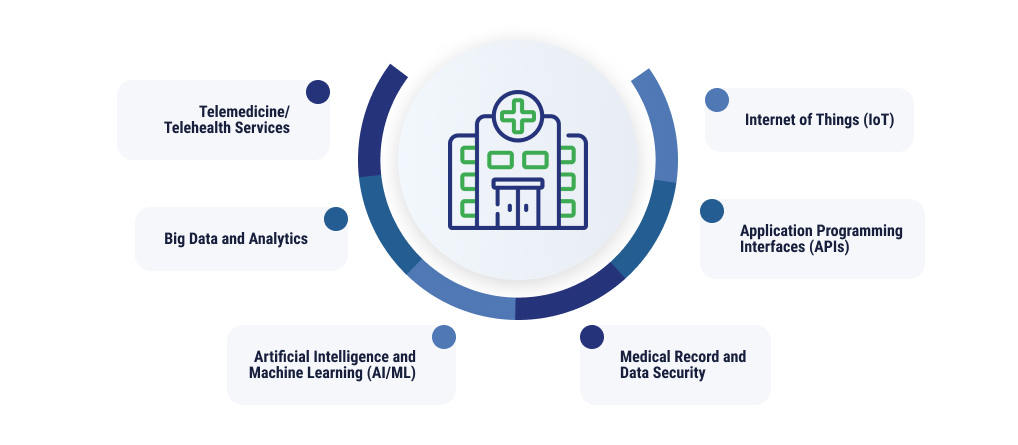
The healthcare sector has long relied on legacy systems, but digital transformation in healthcare is rapidly reshaping the landscape. Cloud computing and emerging technologies unlock new opportunities for operational efficiency, innovation, and outstanding patient care.
As 70% of global health systems prioritize technology investments, the pressure for IT modernization is mounting. We’ll discuss the benefits and drivers of IT modernization, as well as how you can begin your digital transformation journey.
What is Digital Transformation in Healthcare?
Digital transformation in healthcare refers to the application of digital technologies and processes to improve patient outcomes and healthcare operations. This may include the adoption and integration of:
- Electronic health record (EHR) and electronic medical record (EMR) systems
- Telehealth appointments
- Wearable Internet of Things (IoT) devices
- Artificial intelligence and machine learning (AI and ML)
The digital transformation of healthcare is a holistic shift. Rather than simply modernizing IT infrastructure, it involves optimizing people, processes, and platforms to meet evolving patient needs.
What are the Benefits of Digital Transformation in Healthcare?
Digital transformation is important in healthcare because it can improve patient outcomes, accelerate decision-making, spur innovation, reduce costs, and enhance accessibility.

Better Patient Outcomes
When a critical health concern arises, every moment counts. Digital health records improve provider collaboration by enabling the rapid sharing of imaging, medical history, and lab result files. This accelerated process allows for fast, comprehensive diagnoses and treatment plans.
Digital tools, like patient portals, are also increasing the transparency of health data. Patients are empowered to actively participate in and understand care decisions, facilitating productive conversations with providers.
Quicker Innovation and Informed Decision-Making
Real-time data access can both speed up and improve decision-making. Digital transformation, which has led 65% of U.S. hospitals to use AI-assisted predictive tools embedded in their EHR systems, has taken this benefit even further. Providers can now use readily accessible patient information to make time-sensitive, personalized, and data-based decisions faster than ever.
Improved data access can also speed up innovation time. A shorter feedback loop can give healthcare professionals the data they need to understand the programs and features that might be most helpful to staff and patients alike.
Improved Operational Efficiency and Cost Savings
Digital transformation projects increase efficiency in multiple areas. Providers can streamline administrative processes, improve the productivity of their care, prevent medical errors, and cut down on unneeded procedures and tests. Efficiencies such as these can save money and greatly improve patient experiences.
As the global healthcare worker shortage reaches 10 million by 2030, ongoing IT modernization can also support workforce needs. Administrative burden and repetitive data entry are leading contributors to clinician burnout, with many physicians spending hours outside of patient visits finalizing documentation. By streamlining workflows and automating routine tasks, healthcare organizations can give providers more time with patients and reduce time spent on paperwork. Technology-enabled efficiency will be essential for maintaining care quality, reducing stress, and improving retention.
Enhanced Healthcare Accessibility and Convenience
Patient expectations will continue to rise with technological advances. Most people navigating the healthcare system want it to be just as easy to make appointments, view medical records, and get support as it would be to order food online. Digital innovations make this possible while also helping underserved populations, like older adults and rural residents, access care.
Digital technologies enhance the accessibility and convenience of the healthcare experience through capabilities like:
- Telemedicine and telehealth
- Patient portals with 24/7 self-service tools and electronic health records
- Workflow automation
Patient Experience and Value-Based Care
The healthcare sector is shifting toward value-based care, in part due to federal Medicare incentives that reward better quality of care. As a result, reimbursement is increasingly tied to outcomes such as reduced hospital readmissions, improved chronic disease management, and higher patient satisfaction scores (including HCAHPS ratings and Overall Star Ratings).
Modern digital tools enhance the patient experience by:
- Reducing wait times through online scheduling and virtual visits
- Enabling personalized communication via patient portals and mobile apps
- Providing real-time access to lab results, imaging, and treatment updates
- Supporting continuity of care across providers with interoperable records
Investing in IT modernization also helps healthcare systems better track and report on quality metrics, strengthening their financial sustainability while delivering better care experiences.
Key Technologies Driving IT Modernization in Healthcare
Growing patient expectations, paired with the rise in emerging technologies, such as artificial intelligence (AI) and Internet of Things (IoT) devices, are some of the major drivers of cloud adoption in healthcare.

Telemedicine and Telehealth Services
The telehealth market is expected to exceed $455 billion by 2030, representing over 369% growth since 2024. The rising popularity of telemedicine and telehealth services has sparked innovative solutions such as:
- Remote patient monitoring (RPM): Devices that can collect and send patient health data to providers. These include electrocardiogram (ECG) monitors and glucometers.
- Mobile health (mHealth) applications: Patient portals and supplementary mobile apps that support the healthcare journey. These may allow patients to securely message providers, get medication reminders, access health records and educational resources, and schedule appointments.
- HIPAA-compliant video conferencing: Platforms like Zoom for Healthcare and Doxy.me that are tailored for telemedicine. Some healthcare systems even leverage telemedicine carts, which are physical video conferencing setups that can connect providers and patients across locations.
The growth of telemedicine has partially occurred out of necessity for patients who live in rural areas, cannot travel, or face local language barriers. However, it has proven to be a beneficial on-the-go solution for all patients looking to fit an appointment into their busy schedules
Big Data Analytics
While the healthcare industry was once paper-heavy, providers now manage tons of digital data, from supply inventories and insurance data to patient medical charts, research, doctor’s notes, and diagnostic images. According to the World Economic Forum, hospitals now produce the equivalent of 2.3 trillion DVDs of data each year, yet 97% of data continues to go unused.
Immense opportunity lies in fully leveraging the vast amount of healthcare-related data, both patient and operational. The right technologies, integrations, and data flows can improve patient safety and treatment outcomes. For example, data generated from diagnostic equipment, patient monitors, medical images, and IoT devices can help hospitals improve the accuracy of patient diagnoses.
The less positive side to data growth is the cost and time involved in managing huge volumes of data. As a result, cloud computing innovations are a growing part of digital transformation in the health sector. Cloud-based storage solutions offer cost-effective ways to store and back up zettabytes of data. TierPoint’s Imaging Storage-as-a-Service service, designed especially for healthcare organizations, can even support AI imaging workloads for faster diagnostic speeds and operational efficiency.
Data management services from cloud service providers offer further support for secure storage and cost optimization. Likewise, cloud-based content management and EHR applications enable hospitals to store volumes of patient data without the expense of new hardware.
Artificial Intelligence and Machine Learning
The more patient data is used to improve diagnoses and outcomes, the more the healthcare experience improves in general. AI and ML solutions are helping providers get there. Predictive analytics help doctors and industry experts quickly uncover valuable insights, detect early warning signs or emerging risks, and determine optimal treatment strategies for patients.
While automated medical insights still need considerable refinement, McKinsey reports 47% of health organizations have already implemented generative AI, and 38% are actively pursuing GenAI proofs of concept. For many, this is due to the already high effectiveness of artificial intelligence for administrative tasks and documentation.
Hospitals are increasingly piloting the use of AI scribes in clinical documentation and charting. Additionally, healthcare systems are leveraging GenAI for claims and billing automation, patient engagement chatbots, and drug discovery support. These applications reduce administrative burden for clinicians, speed up revenue cycle management, and open new pathways for personalized patient care.
“AI is learning a lot, and it’s going to catch things that trained professionals might not see… Right now, when our physicians are treating and meeting with our patients, even in person, we do use software for our medical records to help transcribe those interactions and be able to automatically chart those interactions.”
– Rob Hall, Cloud Director at Intermountain Healthcare
Internet of Medical Things (IoMT)
The global healthcare IoT market is expected to grow 21.2% annually through 2029. The rising use of digital technologies like RPM and connected medical devices can enable long-term, regular data collection that leads to valuable insights and contextual wellness checkups. These Internet of Medical Things (IoMT) devices include:
- Wearable fitness trackers
- Blood pressure monitors
- Smart inhalers
- Connected insulin pens
- Implantable devices like neurostimulators
- Ingestible sensors
- Robot-assisted surgical devices
The digital capabilities of IoT can also improve healthcare environments. For example, smart beds can prevent pressure ulcers and alleviate physical strain on nurses. Providers can also leverage connected environmental controls to prevent infections and improve patient comfort.
Application Programming Interfaces (APIs)
Cloud platforms that follow healthcare interoperability standards offer cost-effective ways of sharing data between providers. Leveraging application programming interfaces (APIs), hospitals, clinics, pharmacies, and insurers can share data and files over a common cloud platform – a capability that isn’t possible with legacy EHR systems. Cloud-based EHR and EMR applications and healthcare exchanges also enable data sharing between disparate cloud healthcare applications.
In addition, many leading cloud platforms, including Azure Health Data Services and the Google Cloud, have APIs based on healthcare open standards for data exchange. These include the Digital Imaging and Communications in Medicine (DICOM) for diagnostic images and the Fast Healthcare Interoperability Resources (FHIR) for describing data formats and an API for exchanging electronic health records.
Medical Record and Data Security
One of the main reasons healthcare leaders have been tentative about cloud migration is due to security concerns, but trust has slowly been growing. Today, cloud security can be backed by a wide range of technologies including:
- Advanced encryption
- Identity and access management (IAM)
- Intrusion detection and prevention systems (IDPS)
- Real-time security intelligence feeds
- Threat management tools
Managed public cloud providers can offer further support for configurations, as well as additional security services like Managed Detection and Response (MDR). The best cloud services providers will have experience in both the healthcare industry and cloud security, as well as certifications in government regulations and industry best practices.
What Are the Challenges of Digital Transformation in Healthcare?
While digital transformation holds great promise for improving patient outcomes and operational efficiency, healthcare organizations face significant challenges. These include:
- Data Security and Privacy Concerns: The vast amounts of sensitive patient data collected and shared across digital systems make healthcare a prime target for cyberattacks. With new cyber threats rising, ensuring robust protection while enabling data accessibility is an ongoing struggle.
- Integration with Legacy Systems: Many hospitals and clinics still rely on outdated infrastructure. Integrating modern digital tools with these legacy systems often leads to compatibility issues, high costs, and workflow disruptions.
- Regulatory Compliance Complexity: Navigating regulations and frameworks such as HIPAA, HITRUST, GDPR, and other regional standards requires continuous monitoring and adaptation. Compliance adds layers of complexity to IT modernization.
- Ethical Concerns: The use of technologies like AI and digital health tools for clinical decision support raises questions around bias, informed consent, and the responsible use of protected health information (PHI). Balancing innovation with ethical responsibility is critical.
Healthcare IT Transformation Use Cases
Today’s healthcare organizations don’t have to decide between digital transformation, security, and compliance concerns. Modern technologies like the cloud are well-equipped to meet the needs of the industry in a variety of use cases. Here are a couple real-world examples of how IT transformation can drive healthcare system success:
- Dental Associates worked with TierPoint to maintain a hybrid cloud solution that assured patient data and HIPAA-related information remained secure.
- RMS transformed its patchwork of IT infrastructure to a private cloud that enabled rapid scalability and increased reliability. With TierPoint’s hybrid cloud/private cloud DRaaS services, they were able to improve their business continuity and disaster recovery measures, while increasing and maintaining full production capacity.
How to Begin a Digital Transformation Journey as a Healthcare Provider
There has been a drastic increase in digital transformation and cloud adoption across every field, but healthcare as an industry is still behind the curve. In fact, the adoption rate for cloud services in healthcare is 70%, compared to over 90% in other industries. This is, in part, due to healthcare organizations historically feeling a distrust for the cloud.
Modern healthcare providers that want to embrace digital transformation must be mindful of this statistic and approach digital transformation projects with strategy, change management, and training at the forefront.
The Role of Leadership
Effectively leading digital transformation in healthcare requires a clear vision of the objectives your organization wants to reach. With a full understanding of how IT modernization initiatives fit into your broad organizational goals, you can invest in and optimize technologies that support your business model and long-term needs. Once a project begins, senior leaders and managers can facilitate the allocation of resources across departments.
Leaders can also play an important role in establishing internal buy-in. Reiterate to team members that this isn’t a fly-by-night idea by proactively communicating the value of any significant changes, including how new digital systems can improve everyday life for patients and frontline workers. Keep all affected employees informed about the successes, setbacks, and progress of digital transformation efforts along the way.
Defining Your IT Modernization Strategy
After you’ve established a clear message on overall goals, create and deliver a well-defined strategy that addresses:
- The implementation plan. Who needs to be involved? How long will it take? What resources need to be gathered to achieve the initial application scope of digital solutions? How does the end of the process tie to the identified success metrics?
- The current technology infrastructure of the organization. What processes, infrastructure, and data management practices are currently being used?
- The end goals of digital transformation. What does “success” look like when it comes to these efforts? Reducing wait times to hear from doctors, improving patient outcomes, etc.
- The first steps the organization will take. How will your organization reach the desired outcomes of digital transformation?
Prioritizing Change Management
Even with the right strategy and appropriate tools, managing change can be one of the hardest parts of digital modernization. Profound transformation often leads to major digital disruption, affecting technology, workflows, and culture. Healthcare providers who are leading the charge on this type of modernization need to tackle resistance at all levels of the organization in all relevant departments.
Clear messaging around specific digital initiatives is one aspect of change management. However, cultural transformation is often a key component of long-term success. By encouraging a culture of innovation, staying open-minded to new technologies, and empowering healthcare teams to explore their own digital initiatives, leaders can set the tone from the top that organizations don’t have to keep doing things the way they’ve always done them.
Investing in Employee Training and Development
Clinicians, patients, and administrative staff all need to be brought up to speed on what the changes will mean for their everyday tasks and interactions. Some new tools may require training, support, and even professional certifications to spur effective adoption and encourage retention.
During training and in times of change, leaders should not dismiss concerns. Instead, they should open feedback channels for team members to voice their worries about changes to workload or the impact that new technology can have on patient care.
Sometimes, these concerns may point to gaps in internal talent. Our 2025 Technology & IT Modernization Report found that nearly 47% of IT leaders are challenged with a lack of the internal skillsets required for digital transformation. Healthcare organizations struggling to fill their internal cloud skills gaps can benefit from third-party providers with extensive experience in planning and executing digital transformation initiatives.
Accelerate Your Digital Modernization in Healthcare
Healthcare leaders face a dual challenge: delivering exceptional patient care while meeting rigorous compliance and security demands. The right digital foundation makes it possible to protect sensitive health data, reduce downtime, and free up clinicians to focus on patients rather than paperwork.
With a cloud strategy built for healthcare, organizations can:
- Improve patient outcomes with real-time, interoperable data
- Meet compliance confidently with HIPAA, HITRUST, and other regulatory frameworks built into the architecture
- Reduce costs and complexity through cloud efficiency and managed services
- Support innovation with scalable platforms for telehealth, AI, and data analytics
TierPoint partners with healthcare organizations to design, migrate, and manage secure cloud environments across public, private, and hybrid platforms, without vendor lock-in. Explore our digital solutions for healthcare businesses to achieve a future-ready IT foundation that strengthens care delivery and long-term resilience.

FAQs
The cloud is used in healthcare in many different ways – medical imaging, telehealth, electronic health records, streamlining administrative tasks, diagnostic tools through AI/ML, and more.
The four types of digital transformation are business process transformation, business model transformation, organization or cultural transformation, and domain transformation (which deals with expansion into new markets). Often, initiatives in multiple categories are needed to address digital shortcomings and ensure a future-proof healthcare organization.
Digital technologies are making healthcare more effective, efficient, and accessible. Adopting these solutions can drive better patient outcomes and experiences.
